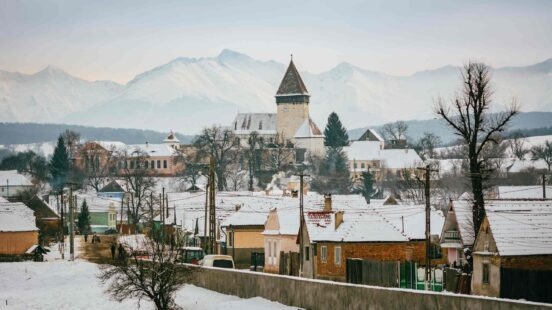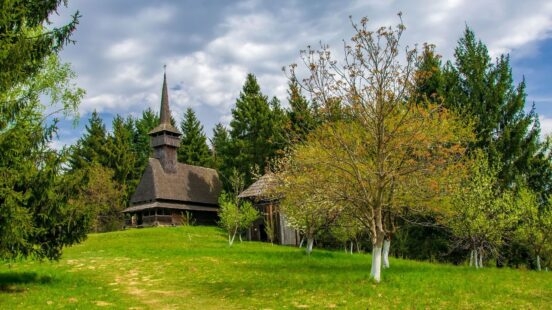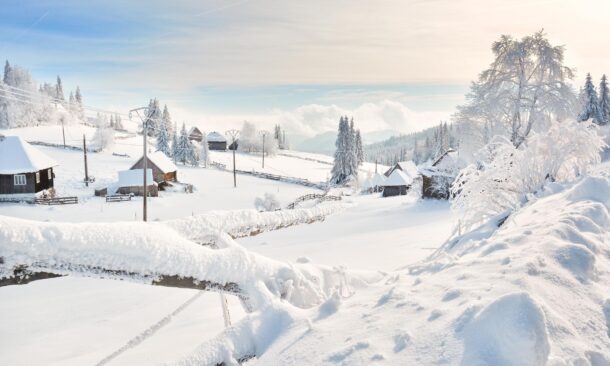The best time to visit Romania is generally from May to September when the temperatures are warm and there’s plenty of sunshine. July and August can get very hot, easily exceeding 30°C (86°F). The shoulder months of May, June and September often offer the best of the warm but not too hot temperatures, particularly in the capital, Bucharest.
Romania’s weather patterns follow a typical eastern European climate. In the east of the continent a subarctic climate means longer, harsher winters compared to those experienced in the west of Europe. Romania is also subject to a humid continental climate, which results in warm, wet summers that create lush, verdant landscapes including forests and wetlands.
The climate in Romania varies not only by season but also by location. This Balkan country is made up of diverse landscapes that can experience different climates at the same time of year. The long, sandy coastline of the Black Sea has a more Mediterranean feel, while the majestic Carpathian Mountains stretch across the country in an arch, reaching freezing, snow-covered heights of 2,500 metres. Beyond the mountains, there are more moderate temperatures on the plateaus and in the foothills. Warmer still, the low-lying Danube Delta's marshes are a haven for birds and wildlife.
When are summer and winter in Romania?
Romania’s seasons follow a similar pattern to its European neighbours. Summer spans the months of June through to August and winter runs from December to February. The summer months are the warmest months of the year with balmy temperatures reaching 35 °C (95 °F) in the south of the country.
Winters in Romania, particularly in the north, west and at higher elevations, can get very cold with temperatures dropping as low as -15˚C (5°F). Although sunshine can break through, the winter skies in Romania are often cloudy and there’s the chance to see a beautiful snow covering, even in the capital of Bucharest.
Romania month-by-month weather guide
Each month in Romania brings something different and special in terms of weather. The seasons are pronounced and the weather ranges from hot, glorious sunny summers to freezing snowy winters – and almost everything in between. Due to the range of locations, activities and climate, there’s always a reason to visit Romania.
To help you understand the weather throughout the year, we’ve asked our travel designers to collate a month-by-month climate guide.
January in Romania
January is typically the coldest month in Romania, where most of the country will be wrapping up warm and enjoying winter activities, which can include sitting by a roaring log fire in our opinion. Temperatures will drop to an average of -6°C (21.2°F) but can get much colder in the mountains or when the freezing winds from Russia blow in, particularly in the west of the country.

February in Romania
In February, Romania remains in the grip of winter, with cold temperatures persisting. While Bucharest may experience a slight increase in temperature, much of the country remains icy and freezing. A rise in humidity may bring occasional rainfall. The geographical climate divide between the west and east is more pronounced in months like February (along with March, September and October) with the east feeling milder compared to the bitter cold in the west.

March in Romania
March officially marks the start of spring in Romania and temperatures start to climb. Seen as a transitional month in terms of weather, the start and end of the month can feel quite different in terms of temperatures. Eastern Romania at the end of March can feel rather spring-like, while the east is still wintery. In the capital, Bucharest, temperatures can reach 12°C (53.6°F) during the day.

April in Romania
Come April, spring is starting to take hold properly in Romania and temperatures are warmer, reaching 20°C (68°F) in low-lying regions. The rains tend to stay at bay in April, although a light shower is always possible. Easter is celebrated across the country with plenty of delicious food and Romanians taking time to spend quality time with their families. It’s worth remembering that some businesses will close for a break over Easter itself.

May in Romania
May is a beautiful spring month in Romania. The spring flowers that started in April are now blooming even at higher altitudes, blanketing the sides of mountains, sweeping valleys and the Transylvanian Plateau. Temperatures are mild in May at 20°C (68°F), however rain showers are common. May is sometimes the wettest month of the year.

June in Romania
June marks the start of summer in Romania, with warm temperatures reaching up to 27°C (80.6°F). The mountains and beaches are popular destinations as people either look to escape the heat at higher altitudes, or revel in them on the beach at the Black Sea. Despite the balmy feel, be prepared for rain showers in June, one of Romania’s wettest months.

July and August in Romania
July and August are peak summer months. Temperatures are hot and the main tourist attractions and beach resorts get busy as families make the most of the school holidays. These hot months, easily reaching 35°C (95°F) in Bucharest, can be a great time to venture into the mountains and countryside for peaceful explorations in cooler temperatures.

September in Romania
September is often considered one of the best months to visit Romania. The temperatures are still mild and the crowds have dispersed after the busy summer period. September is typically a dry month with little rain so it’s perfect for outdoor activities. Down on the coast you can expect temperatures as high as 25°C ( 77°F), while daytime temperatures in the mountains will probably not exceed 11°C (77°F).

October in Romania
Temperatures start to drop significantly in Romania in October as autumn begins properly and starts to nudge towards winter at the end of the month. Coastal areas and low-lying plains should experience daytime temperatures of around 13°C (55.4°F), which can feel pleasant when the sun is shining. That being said, October will see cloudy skies and some rain, particularly in the mountains.

November in Romania
The climate in Romania during November will be decidedly wintery in feel. Temperatures are cold, ranging between 0°C (32°F) and 10°C (50°F). Some rainfall is to be expected and in the higher ranges of the Carpathian Mountains there may also be some snowfall. Although November isn’t necessarily a great time to visit for outdoor activities, it can be a lovely time to explore castles and churches where candles and fires glow during the darker days.

December in Romania
December is mid-winter in Romania so you can expect cold temperatures, snow and plenty of Christmas markets and festivities. Temperatures will easily drop below -3°C (26.6°F) and can feel colder in the east (closer to Russia) and at altitude in the mountains too. December is a great time to visit Romania for outdoor winter activities such as skiing.

Things to do in Romania by season
There are many different activities to experience in Romania. City-based sightseeing can lead to remote escapades to mountains, wine regions and foothills. Certain months are better for specific experiences. To help you plan the best time to visit for your own interests, we’ve asked our travel designers to highlight their favourite things to do, and when to do them.

The best time to visit the royal bee keepers
Romania has an ancient tradition of beekeeping which is still popular today. Many beekeepers, including the royal beekeeper himself, focus on environmentally friendly techniques to keep the bees and their environment thriving. The best time to visit to experience beekeeping is during the warmer summer months from June to September when you can also enjoy hiking and biking around Saxon villages.

The best time to take a wine tour in Banat
Wine culture, along with excellent farm-to-table style cuisine, is popular and well-established in Romania, particularly in the Banat region. Although you can sip on delicious wine all year round, one of the best times to visit vineyards is during autumn, from late September until the end of October. At this time of year, the countryside comes alive with beautiful autumn colours and the grape harvest takes over the rolling vineyards. You may even get to take part during a vineyard tour.

The best time to go birdwatching in the Danube Delta
The best time to go birdwatching in the Danube Delta is from mid-April until the end of October. There’s a wide variety of bird species to look out for throughout the year but during May and October there can be impressive numbers of migratory birds such as short-toed, lesser spotted and booted eagles, sparrowhawks, European honey-buzzards, harriers and red-footed falcons.

The best time to witness picture-book snowy scenes
The best time to visit Romania to see the snow is December and January: mid-winter. At this time even the capital of Bucharest can see snowfall and the twinkling lights, roaring fires and holiday spirit enhance the magical feel. Mid-winter can also be a good time to explore the country's castles, churches and monasteries, which are particularly atmospheric. There are even some more extreme snowy activities for those keen to explore the ski slopes of the Carpathian mountains.
The best time to visit Transylvania
Transylvania’s collection of astoundingly beautiful cities, Gothic architecture, dense fairy-tale forests and lush foothills are best explored from March through to October. At this time of year, the temperatures are mild, so outdoor activities and sightseeing are comfortable. It’s worth mentioning that the summer months of July and August can get very hot as most of Transylvania sits on a plateau, not quite benefiting from the cooler temperatures experienced in the mountains themselves.
The best time to visit the Carpathian Mountains
Many would argue that the best time to visit the Carpathian mountains is during the summer months of July and August, to escape the intense heat in lower-lying areas. Although we agree, spring (March–April) and autumn (September–October) are particularly beautiful. Pretty flowers adorn the mountains in spring and in the autumn flaming red and orange foliage create a stunning backdrop to hikes and sightseeing activities. The warmer temperatures that range from around 12°C (53.6°F) to 20°C (68°F) are perfect for hikes and walks.
The best months to visit Bucharest
Bucharest is a year-round destination with plenty to offer in terms of culture and history. That being said, to be able to enjoy all the city and its immediate surroundings have to offer, the best times to visit are spring (March–April) and autumn (September–October). These shoulder months promise milder temperatures, away from the intense heat of summer (June–August). And, although there is something rather magical about Bucharest in the winter, the colder temperatures combined with rain and snow can make going outside not quite as pleasant.
Whatever you want from your trip in Romania, our experts are ready to help:








